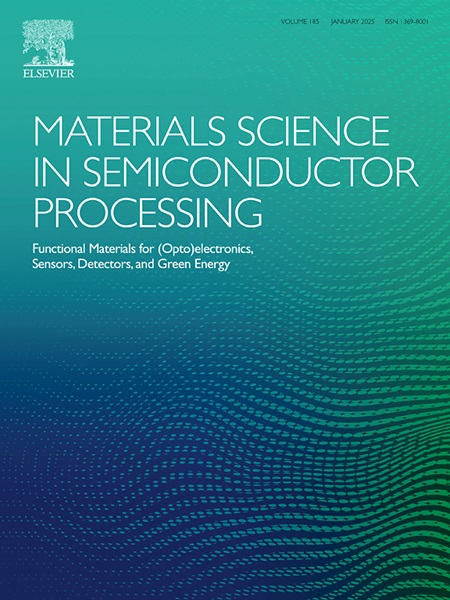Anchored Li2MnO3 nanoparticles on ZnO nanosheets photocatalyst for effective CO2 reduction to CH3OH upon visible illumination
IF 4.2
3区 工程技术
Q2 ENGINEERING, ELECTRICAL & ELECTRONIC
引用次数: 0
Abstract
Photocatalytic reduction of CO2 has garnered significant attention as a sustainable and clean process for producing fuels and chemicals. Various heterojunction-based photocatalysts are explored to effectively reduce CO2 to valuable chemicals. In this study, porous ZnO sheets are fabricated through a hydrothermal process using polyvinylpyrrolidone as a pore builder. Moreover, Li2MnO3 NPs were incorporated into the ZnO nanosheet via the impregnation method with varying Li2MnO3 contents (5–20 %). Li2MnO3 NPs are uniformly dispersed on the porous ZnO sheets, which enhances the photocatalytic performance. The resulting Li2MnO3/ZnO photocatalyst demonstrates an improved CO2 photocatalytic reduction to CH3OH under visible illumination. The 15 % Li2MnO3/ZnO photocatalyst achieves a maximum formation rate of CH3OH at approximately 156.04 μmol g-1h-1, which is 15.85 times greater than that of bare ZnO. Furthermore, the photocatalytic ability after five cycles of reactions remains remarkably stable due to its exceptional stability during CO2 reduction. The enhanced photocatalytic performance of the Li2MnO3/ZnO photocatalyst is attributed to the modification of the bandgap structure, strong visible light response, improved CO2 adsorption, high electronic reduction capability, and effective charge transport capacity. This work contributes to the novel design of highly effective S-scheme mechanisms for the photoreduction of CO2.

锚定Li2MnO3纳米颗粒在ZnO纳米片光催化剂上,在可见光照下有效地将CO2还原为CH3OH
光催化还原二氧化碳作为一种可持续和清洁的生产燃料和化学品的方法已经引起了人们的广泛关注。各种基于异质结的光催化剂被用来有效地将CO2还原为有价值的化学物质。在本研究中,以聚乙烯吡咯烷酮为造孔剂,通过水热法制备了多孔ZnO片材。此外,通过不同Li2MnO3含量(5 - 20%)的浸渍法将Li2MnO3 NPs掺入ZnO纳米片中。Li2MnO3 NPs均匀地分散在多孔ZnO片上,提高了光催化性能。所得Li2MnO3/ZnO光催化剂在可见光下表现出改善的CO2光催化还原CH3OH的效果。在15% Li2MnO3/ZnO光催化剂下,CH3OH的最大生成速率约为156.04 μmol g-1h-1,是裸ZnO的15.85倍。此外,由于其在CO2还原过程中的优异稳定性,经过五个循环反应后的光催化能力仍然非常稳定。Li2MnO3/ZnO光催化剂的光催化性能增强主要归功于带隙结构的改变、强的可见光响应、CO2吸附能力的提高、高的电子还原能力和有效的电荷输运能力。这项工作有助于设计出高效的s -方案机制来光还原CO2。
本文章由计算机程序翻译,如有差异,请以英文原文为准。
求助全文
约1分钟内获得全文
求助全文
来源期刊

Materials Science in Semiconductor Processing
工程技术-材料科学:综合
CiteScore
8.00
自引率
4.90%
发文量
780
审稿时长
42 days
期刊介绍:
Materials Science in Semiconductor Processing provides a unique forum for the discussion of novel processing, applications and theoretical studies of functional materials and devices for (opto)electronics, sensors, detectors, biotechnology and green energy.
Each issue will aim to provide a snapshot of current insights, new achievements, breakthroughs and future trends in such diverse fields as microelectronics, energy conversion and storage, communications, biotechnology, (photo)catalysis, nano- and thin-film technology, hybrid and composite materials, chemical processing, vapor-phase deposition, device fabrication, and modelling, which are the backbone of advanced semiconductor processing and applications.
Coverage will include: advanced lithography for submicron devices; etching and related topics; ion implantation; damage evolution and related issues; plasma and thermal CVD; rapid thermal processing; advanced metallization and interconnect schemes; thin dielectric layers, oxidation; sol-gel processing; chemical bath and (electro)chemical deposition; compound semiconductor processing; new non-oxide materials and their applications; (macro)molecular and hybrid materials; molecular dynamics, ab-initio methods, Monte Carlo, etc.; new materials and processes for discrete and integrated circuits; magnetic materials and spintronics; heterostructures and quantum devices; engineering of the electrical and optical properties of semiconductors; crystal growth mechanisms; reliability, defect density, intrinsic impurities and defects.
 求助内容:
求助内容: 应助结果提醒方式:
应助结果提醒方式:


